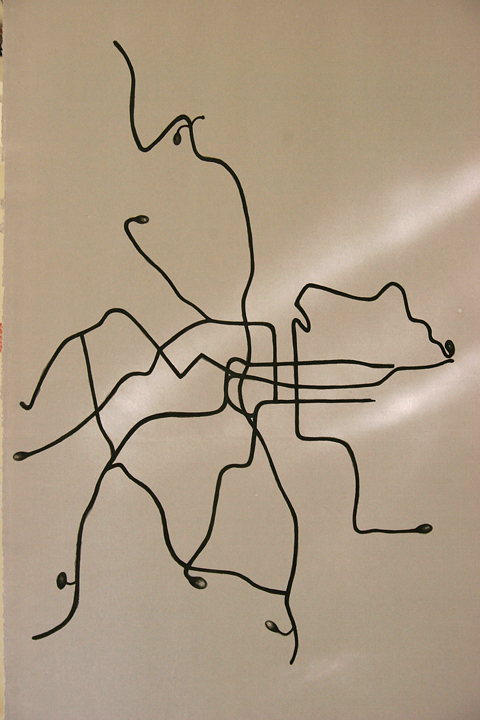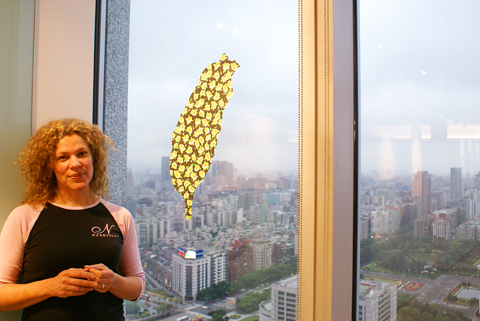Susan Stockwell eyes her recently installed collages covering the walls and windows of the British Trade and Cultural Office’s ultra-slick new location on the 26th floor of the President International Tower. The space has large picture windows and spectacular views of western Taipei, the perfect backdrop for a show inspired by the streets and metro systems of Asia’s large urban centers.
Line Drawing’s collages and installations are the product of a three-month residency at Taipei Artist Village sponsored by the Taiwan-UK Artists Fellowships Program. They expand on Stockwell’s earlier use of everyday materials to map environments, identity and history.
Her paper cutouts of city streets strip urban areas of buildings, parks and people, to show how a city’s development can be traced by looking at its streets. For example, Taipei’s linear grid, developed over the past four decades, contrasts with London’s spider web of streets, which grew haphazardly over centuries.

PHOTO: NOAH BUCHAN, TAIPEI TIMES
Two large collages in the shape of Taiwan — one made from paper with a colorful flower pattern, the other from tea-bags stitched together — reveal the symbols Stockwell thinks represent Taiwan: tea and paper.
Many of the works on display at this exhibition are unpolished; Stockwell has, after all, worked on the project for only three months. But the purpose of the residency, she said, was to get her outside her comfort zone and help her find new sources of inspiration. In showing viewers their daily commute from a new perspective, Line Drawing may do the same its audience, too.
Taipei Times: What inspired you to apply for the fellowship in Taiwan?

PHOTO: COURTESY OF SUSAN STOCKWELL
Susan Stockwell: Two years ago I was doing a residency in Nanjing, China, and I made a piece of work there that was a bit controversial. It was … an impression of China. On the day the exhibition opened [the curators] said they had a problem with the work because it didn’t include Taiwan. I told them that it was an artwork and not a map. And they said they didn’t want to offend any government officials — they said maybe we should take [the work] out [of the show] or put Taiwan in it. I said that this was crazy. I said, ‘Why haven’t you asked me why isn’t Hong Kong in it or why isn’t Macau in it?’”
TT: At the time were you familiar with the cross-strait situation?
SS: A little bit, though not especially. I knew that China thought Taiwan was in China … . But anyway, we had an argument and they were quite adamant that Taiwan is [part of] China … . This made me interested in the whole China-Taiwan debate. So when I saw the residency here I thought I would apply. It was also very much up my street because it was about mapping.
TT: Is the work you’ve created since arriving in Taiwan related to your previous work?
SS: I did work a lot with the idea of maps and mapping and that sort of various ways — whether making dresses out of maps or making a film about taking a line for a walk — it manifests itself in different ways. Essentially, [my] work is often about maps: mapping colonialism, post-colonialism — those sort of issues [involving] humans mapping out the world and taking territories and the idea of ownership. I also look at [a country’s] indigenous material.
TT: If you were to choose a material that symbolizes Taiwan, what would it be?
SS: I think paper — it seems very much a part of the culture and history of the culture. Not just regular paper but cloth-like paper and paper with vibrant colors on them. Though of course two-thirds of the landmass is covered in tea country [she laughs].
TT: Before arriving in Taiwan, did you have the idea of mapping the city streets and subways of different Asian cities?
SS: No I didn’t. I think that I came here with quite an open mind and I didn’t want to come here with a very set agenda. I saw the opportunity of being in a different place for three months away from my life in London as a way of hopefully starting new and different work — which is exactly what I did. And that is a great opportunity because, you know, when you are in your normal life you tend to carry on doing whatever projects you’ve got or whatever commissions you’ve got carrying on in the same sort of vein; and it’s quite good to get shaken up, come to a new place [and] look at the world quite differently. And I feel that — I started two or three new ideas, like the paper map pieces and the calligraphy stitch pieces and the drawings as well, that I can really take forward and do a lot with and develop on to a deeper more elaborate level. So as an artist it was a very useful experience — a very inspirational experience.
TT: Is there any relationship between colonialism and the way cities are mapped?
SS: It tells you about history. Take Taipei and London: one is very old and developed later and one is very young and developed quickly. Obviously, a place like Taipei, where it’s very car-orientated, the car dominates, not the pedestrians and the cityscapes, the building has evolved to suit vehicles. The car has a lot of power here — whereas in London for example, they are taking this power away from the car.
TT: How has living in Taiwan altered your perspective about what you originally experienced in China.
SS: Quite a lot. Having been here for quite a while, I don’t see Taiwan as being part of China. Of course there is a cultural and historic link with China. But I think the culture here is very different and the people are different. Oh, and the food is better.
TT: Is there an experience you’ve had in Taiwan that you perceive now that you can carry back with you.
SS: I think that Taroko Gorge is fantastic and beautiful — quite a magical landscape. And the people of Taiwan are incredibly friendly. Oh, and eating out on the street — the food is just wonderful and that kind of outside culture.

On April 26, The Lancet published a letter from two doctors at Taichung-based China Medical University Hospital (CMUH) warning that “Taiwan’s Health Care System is on the Brink of Collapse.” The authors said that “Years of policy inaction and mismanagement of resources have led to the National Health Insurance system operating under unsustainable conditions.” The pushback was immediate. Errors in the paper were quickly identified and publicized, to discredit the authors (the hospital apologized). CNA reported that CMUH said the letter described Taiwan in 2021 as having 62 nurses per 10,000 people, when the correct number was 78 nurses per 10,000

As we live longer, our risk of cognitive impairment is increasing. How can we delay the onset of symptoms? Do we have to give up every indulgence or can small changes make a difference? We asked neurologists for tips on how to keep our brains healthy for life. TAKE CARE OF YOUR HEALTH “All of the sensible things that apply to bodily health apply to brain health,” says Suzanne O’Sullivan, a consultant in neurology at the National Hospital for Neurology and Neurosurgery in London, and the author of The Age of Diagnosis. “When you’re 20, you can get away with absolute

May 5 to May 11 What started out as friction between Taiwanese students at Taichung First High School and a Japanese head cook escalated dramatically over the first two weeks of May 1927. It began on April 30 when the cook’s wife knew that lotus starch used in that night’s dinner had rat feces in it, but failed to inform staff until the meal was already prepared. The students believed that her silence was intentional, and filed a complaint. The school’s Japanese administrators sided with the cook’s family, dismissing the students as troublemakers and clamping down on their freedoms — with

As Donald Trump’s executive order in March led to the shuttering of Voice of America (VOA) — the global broadcaster whose roots date back to the fight against Nazi propaganda — he quickly attracted support from figures not used to aligning themselves with any US administration. Trump had ordered the US Agency for Global Media, the federal agency that funds VOA and other groups promoting independent journalism overseas, to be “eliminated to the maximum extent consistent with applicable law.” The decision suddenly halted programming in 49 languages to more than 425 million people. In Moscow, Margarita Simonyan, the hardline editor-in-chief of the